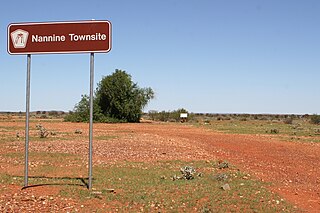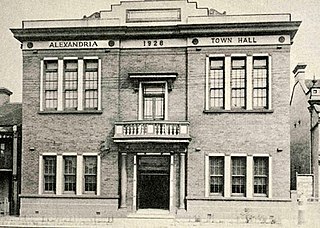Related Research Articles

Cue is a small town in the Mid West region of Western Australia, located 620 km north-east of Perth. At the 2016 census, Cue had a population of 178. Cue is administered through the Cue Shire Council, which has its chambers in the historic Gentlemans Club building. The current president is Ross Pigdon. A Local Government Association biannual forum, better known as the "Cue Parliament" is held twice yearly in May and November.

Waverley Council is a Local government area in the eastern suburbs of Sydney, in the state of New South Wales, Australia. First incorporated on 16 June 1859 as the Municipality of Waverley, it is one of the oldest-surviving local government areas in New South Wales. Waverley is bounded by the Tasman Sea to the east, the Municipality of Woollahra to the north, and the City of Randwick in the south and west. The administrative centre of Waverley Council is located on Bondi Road in Bondi Junction in the Council Chambers on the corner of Waverley Park.

Nannine is a ghost town in the Mid West region of Western Australia. It is located on the northern bank of Lake Anneen, approximately 35 kilometres (22 mi) south-southwest of Meekatharra, and 735 kilometres (457 mi) north-northeast of Perth.

The Shire of Cue is a local government area in the Mid West region of Western Australia, about 420 kilometres (260 mi) east-northeast of the port city of Geraldton and about 650 kilometres (400 mi) north-northeast of the state capital, Perth. The Shire covers an area of 13,623 square kilometres (5,260 sq mi), and its seat of government is the town of Cue.

Day Dawn is a ghost town in the Mid West/upper Murchison region of Western Australia. It was a significant mining town and mine in the late nineteenth century. Located a short distance south-west of Cue, rich gold deposits were discovered there in 1891 by Ned Heffernan, who pegged out what became known as the 'Day Dawn Reef'.

Henry Gregory was an Australian politician. He was a Ministerialist member of the Western Australian Legislative Assembly from 1897 to 1911, representing the electorates of North Coolgardie (1897-1901) and Menzies (1901-1911). He was state Minister for Mines from 1901 to 1904 under George Leake and Walter James and Minister for Mines and Railways from 1905 to 1911 under Hector Rason, Newton Moore and Frank Wilson. He rose to become Treasurer from 1910 to 1911, a role that also entailed him acting as Premier if Wilson was absent, but lost his seat at the 1911 state election.

The Municipality of Alexandria was a local government area of Sydney, New South Wales, Australia. Originally part of the municipalities of Redfern from 1859 and Waterloo from 1860, the Borough of Alexandria was proclaimed on 27 August 1868. With an area of 4.2 square kilometres, it included the modern suburbs of Alexandria, Beaconsfield and parts of Eveleigh, St Peters and Erskineville. After a minor boundary change with the Municipality of Erskineville in 1908, the council was amalgamated with the City of Sydney, along with most of its neighbours, with the passing of the Local Government (Areas) Act 1948, although the former council area was later transferred in 1968–1982 and 1989–2004 to the South Sydney councils.
The Bulong Road District was an early form of local government area on the Western Australian goldfields. It was formally established on 20 December 1899, providing a basic form of local government to the rural areas around the mining town of Bulong, which had already incorporated as the Municipality of Bulong in 1896. However, it took several months before the road board had practically established itself, and in March 1900 the Kalgoorlie Sun wrote: "...a roads board has been gazetted for Bulong, all on its own. But now they have their roads board, they don't know what to do with it." The first road board election took place on 3 April 1900. The road board met at the municipality's office, the council chambers, in Bulong township.
The Municipality of Coolgardie was a local government area in Western Australia, centred on the town of Coolgardie.
The Geraldton Road District was an early form of local government area in the Mid West region of Western Australia. It was based in the town of Geraldton, although Geraldton was not part of the road district, having been separately incorporated as the Municipality of Geraldton.
The Kanowna Road District was an early form of local government area on the Western Australian goldfields.
The Nannine Road District was an early form of local government area on the Western Australian goldfields of the Mid West region.
The Municipality of Victoria Park was a local government area in the inner eastern suburbs of Perth, Western Australia.
The Municipality of Cue was a local government area in Western Australia centred on town of Cue.
The Municipality of Nannine was a local government area in Western Australia, centred on the mining town of Nannine.
The Municipality of Broad Arrow was a local government area in Western Australia centred on the mining town of Broad Arrow.
The Municipality of Broome was a local government area in Western Australia centred on the coastal town of Broome. It existed from 1904 to 1918.
The Municipality of Bulong was a local government area in Western Australia centred on the mining town of Bulong.
The Municipality of Busselton was a local government area in Western Australia, centred on the town of Busselton.
The Municipality of Esperance was a local government area in Western Australia centred on the coastal town of Esperance. It existed from 1895 until 1908.
References
- 1 2 "Municipality Boundary Amendments Register" (PDF). Western Australian Electoral Distribution Commission. Retrieved 11 January 2020.
- ↑ "DAY DAWN MUNICIPAL COUNCIL". The Murchison Times and Day Dawn Gazette . Western Australia. 24 December 1896. p. 2. Retrieved 26 January 2020– via Trove.
- ↑ "NUGGETS". The Murchison Times and Day Dawn Gazette . Western Australia. 10 June 1897. p. 3. Retrieved 26 January 2020– via Trove.
- ↑ "Day Dawn Municipal Council". The Murchison Times and Day Dawn Gazette . Western Australia. 28 March 1907. p. 3. Retrieved 26 January 2020– via Trove.
- ↑ "Day Dawn Council". The Murchison Times And Day Dawn Gazette . Western Australia. 16 November 1911. p. 1. Retrieved 26 January 2020– via Trove.
- ↑ "DAY DAWN MUNICIPAL COUNCIL". The Murchison Times and Day Dawn Gazette . Western Australia. 24 October 1901. p. 2. Retrieved 26 January 2020– via Trove.
- ↑ "DAY DAWN". The West Australian . Western Australia. 24 October 1901. p. 4. Retrieved 26 January 2020– via Trove.
- ↑ "Friday, September 2, 1904" (PDF). Government Gazette of Western Australia. Retrieved 26 January 2020.
- ↑ "DAY DAWN MUNICIPAL COUNCIL". The Murchison Times and Day Dawn Gazette . Western Australia. 25 September 1902. p. 2. Retrieved 26 January 2020– via Trove.
- ↑ "Friday, October 11, 1912" (PDF). Government Gazette of Western Australia. Retrieved 27 January 2020.
- ↑ "Exit Councils". The Murchison Times and Day Dawn Gazette . Western Australia. 2 November 1912. p. 2. Retrieved 26 January 2020– via Trove.
- ↑ "General News". Mount Magnet Miner and Lennonville Leader . Western Australia. 19 October 1912. p. 2. Retrieved 26 January 2020– via Trove.